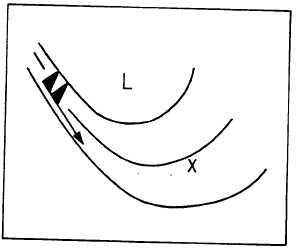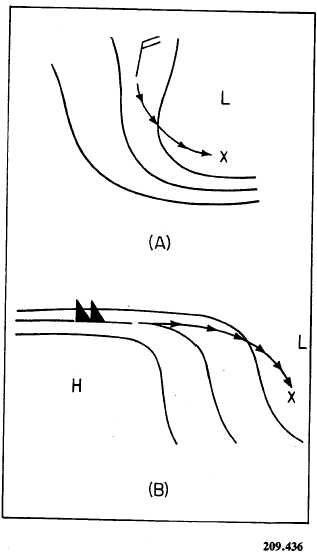|
| |
[ Back ] [ Home ] [ Up ] [ Next ]
Click
here to Order your Radar Equipment Online
CONVERGENCE AND DIVERGENCE
(COMPLEX
MOTIONS)
The 300-mb chart is the primary chart used to
determine areas of horizontal convergence and divergence;
however, if a sparsity of reports limits
its
use, the 500-mb chart may be substituted. Looking
at an analyzed 300-mb chart, you have
to examine the winds in relation to height contours
to locate areas of divergence. Look for areas
where high-speed winds are approaching weak
cyclonically curved contour gradients. A jet maximum
moving south on the west side of a major
trough is a good example of this type of wind-contour
relationship. See figure 8-4-4. The jet
winds push air at excessive speeds, and when

Figure
8-4-4.Divergence illustrated.

Figure
8-4-5.Convergence illustrated,
the
air is forced to negotiate the curve in the contour
(much like a car trying to negotiate a bend in
the road while moving at high speed), it fails. The
air continues in a straight line and crosses the contours
to the right of its intended path. Based on
resultant forces, where the contours weaken and
curve cyclonically, the Coriolis force and centrifugal
force combine to overpower the pressure
gradient force; and the air flows out of the
system, across contours, into an area of higher heights.
Divergence occurs downstream to the left of
the path of the outflowing air. If these high-speed
winds continue for a sustained period of
time, large height falls occur in this area. Areas
of convergence are associated with two wind-contour
relationships. The first is where low-speed winds
approach strong cyclonically curved contour
gradients (fig. 8-4-5, view A). A good example
of this is where a jet maximum is located on
the east side of a major trough and weak winds are
on the west side. As the air on the west side moves
slowly toward the base of the trough, it encounters
the stronger cyclonically curved contour
gradient associated with the trailing edge of
jet stream winds. The pressure gradient becomes
very intense in this area and the Coriolis and
centrifugal forces are unable to balance it. In
order to reestablish the balance of forces, the slow-moving
air is forced to move to the left of its
intended path. As the air moves to the left, it crosses
contours, and theres a net inflow of air into
the trough. The convergence occurs where the
air flows across the contours.
The second wind-contour relationship that creates
convergence occurs when high-speed winds approach
winds of lower speeds in weak anti-cyclonically curved
contour gradients (fig. 8-4-5, view
B). An example you might look for would have
a jet maximum approaching the top of a sharply
curved ridge. As the air is pushed into the ridge
at excessive speeds, it is unable to make the sharp
turn necessary to follow the contours. Here the
centrifugal force and pressure gradient force combine
to overpower Coriolis force. The air is forced
to cross the contours to the left of its intended
path and flows into the downstream trough.
The convergence occurs to the right of the
path of inflowing air.
[ Back ] [ Home ] [ Up ] [ Next ]
|
